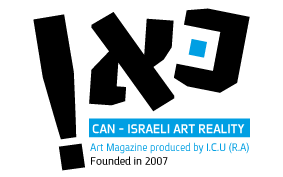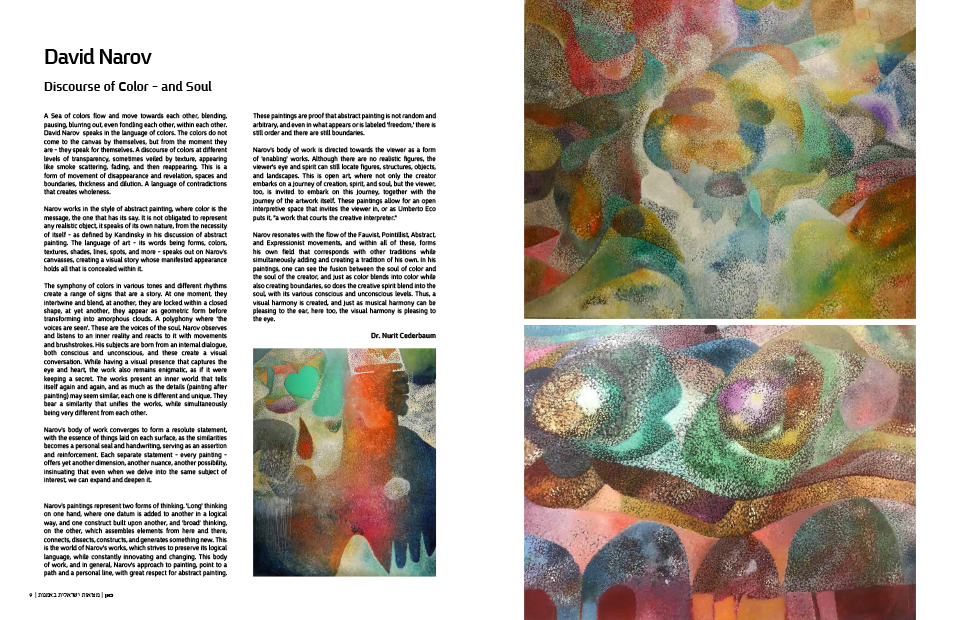
| Home Page | Editor Notices | Museums | Galleries | Publication | Donation | Contact Us |


 | |||||||||||||||
| |||||||||||||||


| |||||||||||||||
| David Narov / Discourse of Color – and Soul |
A Sea of colors flow and move towards each other, blending, pausing, blurring out, even fondling each other, within each other. David Narov speaks in the language of colors. The colors do not come to the canvas by themselves, but from the moment they are – they speak for themselves. A discourse of colors at different levels of transparency, sometimes veiled by texture, appearing like smoke scattering, fading, and then reappearing. This is a form of movement of disappearance and revelation, spaces and boundaries, thickness and dilution. A language of contradictions that creates wholeness. Narov works in the style of abstract painting, where color is the message, the one that has its say. It is not obligated to represent any realistic object, it speaks of its own nature, from the necessity of itself – as defined by Kandinsky in his discussion of abstract painting. The language of art – its words being forms, colors, textures, shades, lines, spots, and more – speaks out on Narov's canvasses, creating a visual story whose manifested appearance holds all that is concealed within it. The symphony of colors in various tones and different rhythms create a range of signs that are a story. At one moment, they intertwine and blend, at another, they are locked within a closed shape, at yet another, they appear as geometric form before transforming into amorphous clouds. A polyphony where 'the voices are seen'. These are the voices of the soul. Narov observes and listens to an inner reality and reacts to it with movements and brushstrokes. His subjects are born from an internal dialogue, both conscious and unconscious, and these create a visual conversation. While having a visual presence that captures the eye and heart, the work also remains enigmatic, as if it were keeping a secret. The works present an inner world that tells itself again and again, and as much as the details (painting after painting) may seem similar, each one is different and unique. They bear a similarity that unifies the works, while simultaneously being very different from each other. Narov's body of work converges to form a resolute statement, with the essence of things laid on each surface, as the similarities becomes a personal seal and handwriting, serving as an assertion and reinforcement. Each separate statement – every painting - offers yet another dimension, another nuance, another possibility, insinuating that even when we delve into the same subject of interest, we can expand and deepen it. Narov's paintings represent two forms of thinking. 'Long' thinking on one hand, where one datum is added to another in a logical way, and one construct built upon another, and 'broad' thinking, on the other, which assembles elements from here and there, connects, dissects, constructs, and generates something new. This is the world of Narov's works, which strives to preserve its logical language, while constantly innovating and changing. This body of work, and in general, Narov's approach to painting, point to a path and a personal line, with great respect for abstract painting. These paintings are proof that abstract painting is not random and arbitrary, and even in what appears or is labeled 'freedom,' there is still order and there are still boundaries. Narov's body of work is directed towards the viewer as a form of 'enabling' works. Although there are no realistic figures, the viewer's eye and spirit can still locate figures, structures, objects, and landscapes. This is open art, where not only the creator embarks on a journey of creation, spirit, and soul, but the viewer, too, is invited to embark on this journey, together with the journey of the artwork itself. These paintings allow for an open interpretive space that invites the viewer in, or as Umberto Eco puts it, "a work that courts the creative interpreter." Narov resonates with the flow of the Fauvist, Pointillist, Abstract, and Expressionist movements, and within all of these, forms his own field that corresponds with other traditions while simultaneously adding and creating a tradition of his own. In his paintings, one can see the fusion between the soul of color and the soul of the creator, and just as color blends into color while also creating boundaries, so does the creative spirit blend into the soul, with its various conscious and unconscious levels. Thus, a visual harmony is created, and just as musical harmony can be pleasing to the ear, here too, the visual harmony is pleasing to the eye. Dr. Nurit Cederbaum Read more  |
| all rights reserved - CAN ISRAELI ART REALITY |
| סייבורג מחשבים - בניית אתרים |